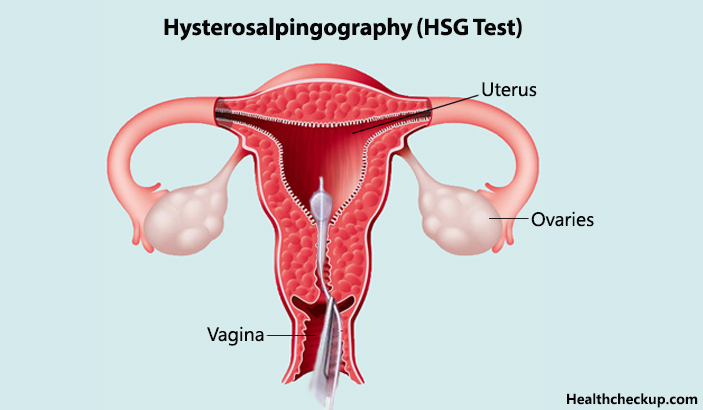A hysterosalpingography test or the HSG Test is an X-ray procedure mainly done to view the inside of the uterus and fallopian tubes which are important parts of the female reproductive system.
A healthy pregnancy is possible only when the ovaries function properly to produce eggs every month, and the fallopian tubes are open to receive the eggs produced by the ovaries and let the male sperms enter the egg, and pass on the fertilized egg to the uterus, which also needs to be in good shape to receive the fertilized egg.
A blockage in the fallopian tubes might cause trouble in a female getting pregnant. The blockage in fallopian tubes could occur for many reasons, and the gynecologist uses the hysterosalpingography test or HSG test to diagnose the cause for the blockage of the fallopian tubes and evaluate the health of the uterus.
What is an HSG Test?
The Hysterosalpingography test or HSG test is an important test conducted by gynecologists to evaluate the fertility potential of a female. The test is a radiological procedure that uses an X-ray to view the insides of the fallopian tubes and the uterus. It is usually done in the radiological department of a hospital and the procedure usually takes less than 5 minutes, and the patient will be able to return home on the same day. The X-ray taken during the test reveals any abnormalities in the uterus or the blockage or dilation of the fallopian tubes.
The HSG test is usually ordered by doctors when female experiences recurrent miscarriages, to check for the shape of the uterus because an abnormally shaped uterus is often one of the reasons for miscarriages. About 10 to 15% of the females who experience recurrent pregnancy loss generally show an abnormally shaped uterus in the hysterosalpingography test, and sometimes, these uterine problems can be corrected by surgery.
The HSG test also reveals any blockage in the fallopian tubes which might be preventing the fertilization of the egg by the male sperm and inhibiting pregnancy.
HSG Test Preparation
The HSG Test is done by a gynecologist about 5 days after your period has ended to ensure that you aren’t pregnant. Also, the test needs to be done before ovulation to avoid any exposure to radiation during early pregnancy.
Your gynecologist might advise you to take an over-the-counter painkiller like ibuprofen or naproxen about one hour before the procedure if you’re getting the hysterosalpingography test without anesthesia, as the test procedure causes a little cramping. The doctor might also prescribe an antibiotic before you go for the test.
Can I eat or drink before an HSG Test?
You will be advised not to eat or drink for 12 hours prior to the test if you’re having the hysterosalpingography test under anesthesia.
The doctor might give you other recommendations that she finds necessary before you undergo the test. But, as a patient, it is important to inform your doctor about the following details before you undergo the HSG test
- Tell the doctor if you’re pregnant or think you might be pregnant.
- Inform her about any pelvic infection or Sexually Transmitted Disease that you have at the time of undergoing the test.
- Tell her if you have asthma or have experienced any kind of allergies in the past, especially if you’re allergic to the iodine dye which is used in the hysterosalpingography test procedure.
- Inform the doctor if you have any bleeding problems or are currently taking any blood thinning medication such as warfarin or aspirin.
- Notify the doctor if you have any history of diabetes or kidney disease and if you’re taking any medication for these conditions. This is because the iodine dye used in the HSG Test procedure might cause kidney damage in people with poorly functioning kidneys, and the doctor might want to conduct blood tests to evaluate your kidneys’ function to avoid any risks caused by the hysterosalpingography test procedure.
The HSG Test procedure only takes a few minutes, as mentioned before, and you’re likely to be able to drive back home by yourself after the procedure. However, it is advisable to have someone drive you back in case you don’t feel too well after the procedure.
The HSG Test Procedure
The Procedure for the Hysterosalpingography Test is as Follows
Your gynecologist will have you lie down on a table under an X-ray imager called the fluoroscope, with your legs placed apart, and your feet placed on stirrups.
- Next, she’ll insert a speculum into the vagina to keep it open and clean the cervix.
- Then your uterus is filled with a liquid that contains iodine through a thin tube called a cannula inserted into the cervix. The iodine contrasts with the uterus and fallopian tubes and makes them visible on the X-ray.
- The doctor will then remove the speculum and take X-ray images with the fluoroscope. The contrasting fluid shows the outline of the uterus and fallopian tubes and how the fluid moves through them.
- You might be asked to move around by the doctor to help her get side views, and you might experience slight cramping.
- The doctor will remove the cannula once the images are completely taken.
- You may be asked to take your legs off the stirrups and remain lying on the table for a while till you recover from the cramping that you experienced due to the injection of the contrasting liquid.
The results and images of the hysterosalpingography test will be available immediately, and the doctor will discuss the test results with you.
Is the HSG Test Painful?
Many women are anxious before undergoing the hysterosalpingography test because they fear that the procedure might be painful. But, to be truthful, it varies from one person to another. Some women might experience mild-to-moderate cramping while some women won’t feel anything. Very few women complain of severe cramping during the procedure. And, some women will agree that the fear of pain they suffered before the procedure was much more annoying than any discomfort that they felt during the procedure.
What Happens after the HSG Test?
After the test, you may have a sticky vaginal discharge as the contrasting fluid used during the procedure drains out of the uterus. The discharge may be tinged with blood, and you can use a sanitary pad, but not a tampon to deal with the vaginal discharge. Other symptoms that you experience after the hysterosalpingography procedure include
- Slight vaginal bleeding
- Moderate cramping
- Feelings of dizziness and stomach discomfort
HSG Test Side Effects
Though undergoing a hysterosalpingography test is not a very pleasant experience, and might cause you some discomfort during and immediately after the procedure, you will be able to recover quickly and get back to your normal activities by the next day.
Some women experience cramping for about 2 days after the test, but it’s nothing to worry about. Another common side-effect of the HSG test includes spotting that could last for as long as 3 days after the test. However, you should contact your doctor immediately if you experience heavy bleeding, severe pain, or fever, because these are not normal side effects, and their causes need to be investigated as quickly as possible.
HSG Test Risks
Severe problems occurring after an HSG test are rare, but not impossible. The test may cause damage to cells due to the exposure of the tissue to radiation. There are also chances of pelvic infection, salping it is or the infection and inflammation of the fallopian tubes, and endometritis or the inflammation of the lining of the uterus. Also, sometimes the patient might develop an allergic reaction to the dye used during the test procedure.
However, it is very important to call your doctor if you experience the following symptoms after an HSG Test Procedure
- Vomiting
- Dizziness or sudden fainting
- Fever with chills
- Foul-smelling vaginal discharge
- Heavy vaginal bleeding
- Severe pain or cramps in the abdomen
Medically Reviewed By

I am an experienced Medical/Scientific writer with a passion for helping people live a happy healthy life. My thirst for writing has followed me throughout the years – it is there when I wake up, lingering at the edges of my consciousness during the day, and teases me at night as I go to sleep.









